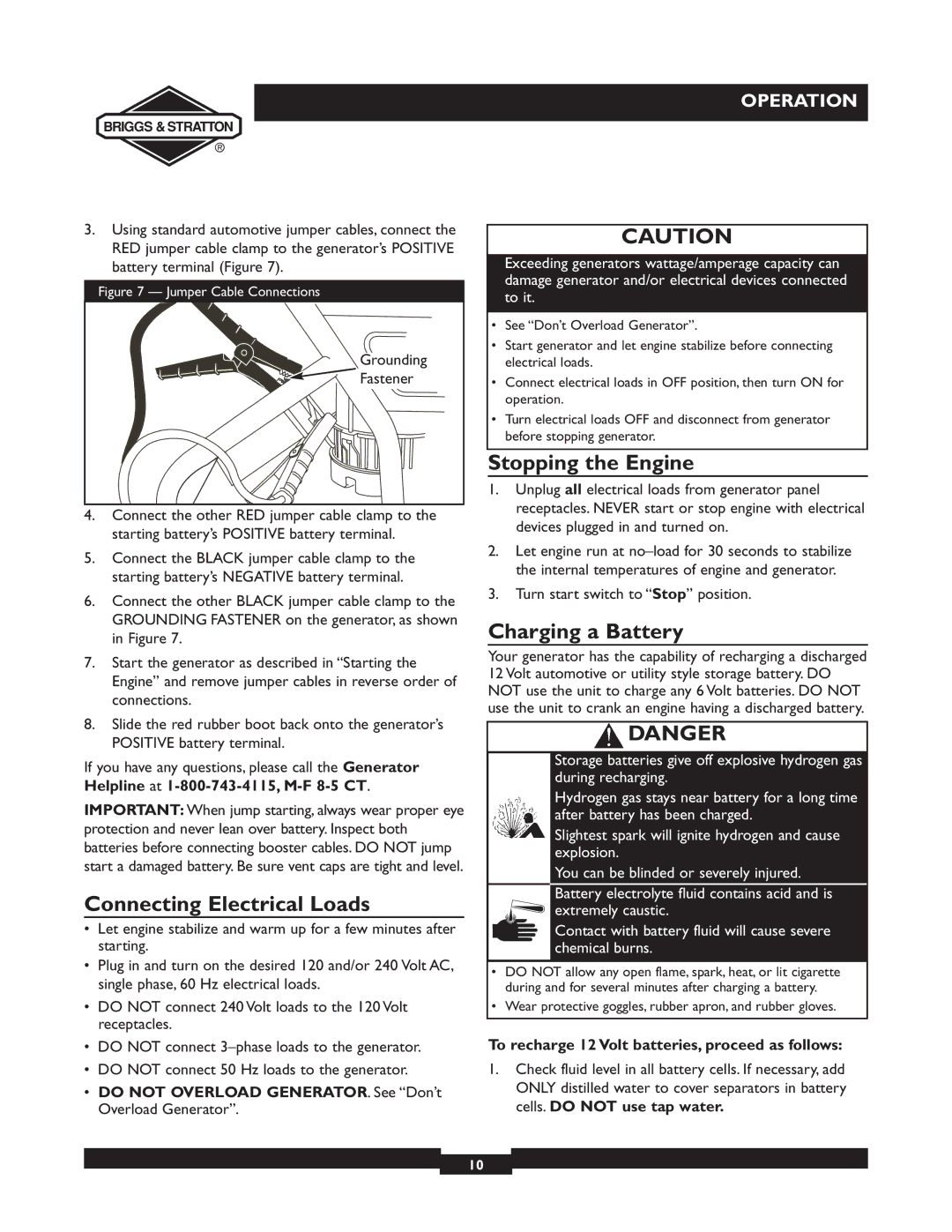
3.Using standard automotive jumper cables, connect the RED jumper cable clamp to the generator’s POSITIVE battery terminal (Figure 7).
Figure 7 — Jumper Cable Connections
Grounding |
Fastener |
4.Connect the other RED jumper cable clamp to the starting battery’s POSITIVE battery terminal.
5.Connect the BLACK jumper cable clamp to the starting battery’s NEGATIVE battery terminal.
6.Connect the other BLACK jumper cable clamp to the GROUNDING FASTENER on the generator, as shown in Figure 7.
7.Start the generator as described in “Starting the Engine” and remove jumper cables in reverse order of connections.
8.Slide the red rubber boot back onto the generator’s POSITIVE battery terminal.
If you have any questions, please call the Generator Helpline at
IMPORTANT: When jump starting, always wear proper eye protection and never lean over battery. Inspect both batteries before connecting booster cables. DO NOT jump start a damaged battery. Be sure vent caps are tight and level.
Connecting Electrical Loads
•Let engine stabilize and warm up for a few minutes after starting.
•Plug in and turn on the desired 120 and/or 240 Volt AC, single phase, 60 Hz electrical loads.
•DO NOT connect 240 Volt loads to the 120 Volt receptacles.
•DO NOT connect
•DO NOT connect 50 Hz loads to the generator.
•DO NOT OVERLOAD GENERATOR. See “Don’t Overload Generator”.
OPERATION
CAUTION
Exceeding generators wattage/amperage capacity can damage generator and/or electrical devices connected to it.
•See “Don’t Overload Generator”.
•Start generator and let engine stabilize before connecting electrical loads.
•Connect electrical loads in OFF position, then turn ON for operation.
•Turn electrical loads OFF and disconnect from generator before stopping generator.
Stopping the Engine
1.Unplug all electrical loads from generator panel receptacles. NEVER start or stop engine with electrical devices plugged in and turned on.
2.Let engine run at
3.Turn start switch to “Stop” position.
Charging a Battery
Your generator has the capability of recharging a discharged 12 Volt automotive or utility style storage battery. DO NOT use the unit to charge any 6 Volt batteries. DO NOT use the unit to crank an engine having a discharged battery.
![]() DANGER
DANGER
Storage batteries give off explosive hydrogen gas during recharging.
Hydrogen gas stays near battery for a long time after battery has been charged.
Slightest spark will ignite hydrogen and cause explosion.
You can be blinded or severely injured.
Battery electrolyte fluid contains acid and is extremely caustic.
Contact with battery fluid will cause severe chemical burns.
•DO NOT allow any open flame, spark, heat, or lit cigarette during and for several minutes after charging a battery.
•Wear protective goggles, rubber apron, and rubber gloves.
To recharge 12 Volt batteries, proceed as follows:
1.Check fluid level in all battery cells. If necessary, add ONLY distilled water to cover separators in battery cells. DO NOT use tap water.
10
